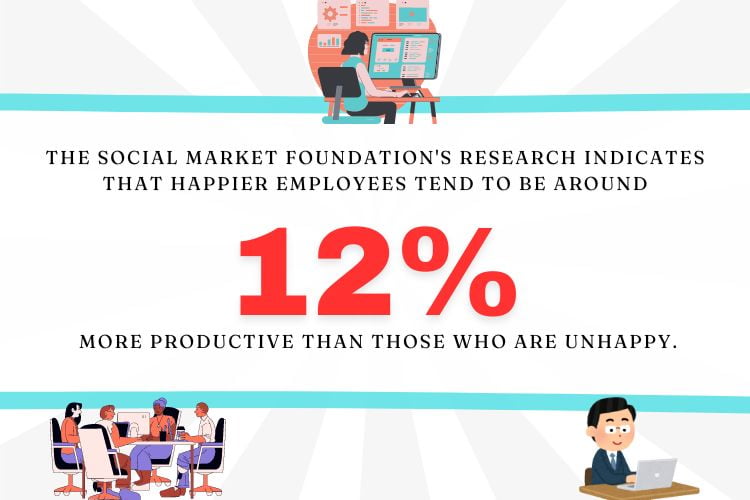Employee retention is critical for any organization’s success. The costs associated with employee turnover can be staggering. Losing an employee can cost a company 2-10 times that employee’s salary in recruiting, hiring, and training a replacement. Employees are your company’s most valuable asset, so keeping turnover rates low through effective retention strategies needs to be a top priority. In this article, we’ll discuss how to retain employees without money.
According to a 2021 report, disengaged employees are twice as likely to leave their jobs. Focusing on employee retention allows you to maintain continuity, preserve institutional knowledge, and reduce disruptive recruitment cycles. Ultimately, putting resources into retention saves money and protects your investment in talent.

Satisfied, engaged employees are also more productive, provide better customer experiences, and contribute to a positive work culture. In today’s competitive hiring market, retaining top talent is more critical than ever. Prioritizing retention needs to be an integral part of your company’s success strategy.
Jump To Section
What Are Some Good Ways to Retain Employees Without Money?

Understand Why Employees Leave
Retaining top talent is crucial for any organization’s success. Before implementing retention strategies, it’s important to understand why employees choose to leave in the first place. Some of the most common reasons include:
Poor organizational culture – Employees want to feel engaged and connected to their workplace. A weak or negative culture leads to disengagement. Factors like lack of trust, inclusion, collaboration, and transparency contribute to poor culture.
Lack of growth and development – Employees want opportunities to continuously learn new skills and advance their careers. Insufficient training, mentorship, and promotion prospects will motivate them to leave.
Weak management – Employees don’t leave companies, they leave managers. Poor leadership, lack of support from managers, and minimal feedback cause employees to become dissatisfied.
Compensation – While pay isn’t everything, feeling adequately compensated and rewarded is important. Stagnant pay, lack of raises and bonuses, and compensation not matching market rates contribute to turnover.
By recognizing these core reasons, organizations can proactively retain talent by fostering a positive culture, enabling growth and development, providing strong leadership, and ensuring fair compensation. Addressing these foundational areas is key to boosting employee retention.
Create a Positive and Engaging Work Environment
A positive and engaging work environment is key for retaining employees without additional spending. Focus on fostering a culture of open communication, collaboration, and belonging among your team.
- Encourage open dialogue and feedback. Allow employees to voice concerns and suggestions without judgment. Make sure communication flows top-down and bottom-up.
- Promote team building with group activities and social events. When employees feel connected to their coworkers, they are more engaged and less likely to leave.
- Recognize contributions and celebrate wins. Highlight employee achievements at meetings or in newsletters. Shared success builds morale.
- Get to know your employees as people. Learn about their skills, interests, and aspirations. Employees want to feel valued as individuals.
- Keep an open-door policy. Make yourself available to listen to employees. Visibility and approachability help build trust.
- Survey employees regularly. Anonymous pulse surveys provide insight into engagement levels and areas for improvement.
- Address conflicts quickly and fairly. Left unresolved, tensions between employees can spread and worsen.
- Welcome new hires warmly. Have an onboarding buddy program to help them integrate into the team and culture.
With a little effort, you can cultivate an environment where employees feel invested in their work and each other. This sense of connection and community is invaluable for retention.
Offer Flexibility and Remote Work Options

Giving employees flexibility in where and when they work is one of the most powerful ways to increase retention without spending money. Offering options like remote work, compressed work weeks, and flexible work scheduling demonstrates that you trust employees and want to accommodate their needs.
With remote work, employees can avoid long commutes and have more control over their schedules. Letting staff work from home even one day per week can greatly increase job satisfaction. Compressed work weeks, where employees work longer days but have an extra day off, can also improve work-life balance.
Flexibility empowers employees and shows you value their personal needs. Consider allowing employees to adjust their start and end times, or work four 10-hour days instead of five 8-hour days. Floating holidays and unlimited vacation allow employees to take time off when they need it.
Flexibility requires open communication between managers and staff. Set clear expectations about online availability, response times, and deliverables. Managers should track results rather than time spent at the desk.
When you provide flexibility and trust, employees will reciprocate with increased dedication, productivity, and loyalty. Flexibility is a powerful perk for retaining top talent.
Provide Learning and Development Opportunities
Providing learning and development opportunities for employees is one of the most effective ways to retain talent without spending money. Employees want to feel that their company cares about helping them grow professionally. Offering training, mentorship programs, and tuition assistance for advanced degrees or certifications shows that you’re invested in their future success.
Implementing training programs related to employees’ current roles keeps skills sharp, while also demonstrating your commitment to their continuous learning. Pairing junior team members with more experienced mentors gives them access to insider knowledge and advice for advancing their careers. Offering tuition reimbursement incentivizes employees to pursue additional education like advanced degrees, which benefits both them and your organization.
Investing in professional development makes employees feel valued and gives them the skills needed for promotions and career advancement within your company. Rather than losing top talent to other organizations with better learning opportunities, you can nurture and retain engaged employees by facilitating their growth. Development opportunities lead to increased job satisfaction, higher retention rates, and a stronger talent pipeline for leadership roles.
Give Employees a Voice

Employees want to feel heard and have input into decisions that affect their work. Giving employees a voice promotes engagement and shows you value their opinions. There are a few ways to do this:
- Conduct regular employee surveys to get feedback on job satisfaction, company culture, manager relationships, and other aspects. Use survey results to identify areas for improvement.
- Hold focus groups or roundtable discussions where employees can share ideas and perspectives. Dedicate time in staff meetings for open Q&A as well.
- Maintain an open-door policy where employees are comfortable approaching leadership with questions, concerns, and suggestions. Be receptive to feedback.
- Before implementing policy or workflow changes, get input from affected teams. They may spot potential problems or have useful ideas to improve rollouts.
- Consider having employee representatives on committees or boards that guide company decisions. This gives staff a voice at the leadership level.
- Schedule skip-level meetings where employees can talk directly to senior leaders, not just their direct managers. This builds trust and transparency.
Giving employees an avenue to provide feedback makes them feel valued. It also helps you make better-informed decisions by tapping into insights from your team members. A culture that embraces employee voice leads to greater commitment and retention.
Set Clear Goals and Enable Career Growth
Setting clear goals and enabling career growth are powerful yet budget-friendly ways to boost employee retention and improve employee engagement. Employees want to feel like their work matters and that they are progressing professionally. As a manager, you can help in a few key ways:
- Help employees set meaningful development plans with specific skills and knowledge they want to acquire. Make sure these plans align with their interests and aspirations. Check-in regularly to track progress and provide support.
- Offer opportunities for lateral or upward mobility within the company through internal transfers and promotions. Make sure employees are aware of potential career paths and what it takes to advance.
- Provide stretch assignments, special projects, and responsibilities that help employees build new skills. These developmental experiences show you’re invested in their growth.
- Be open about advancement opportunities and post open roles internally first before recruiting externally. Give qualified internal candidates the chance to apply and interview.
- If budgets allow, offer tuition reimbursement or support for advanced degrees, certificates, training programs etc. This investment in learning pays dividends in retention.
- Beyond formal development, empower employees to lead new initiatives or teams. This on-the-job experience lets them showcase their strengths and build leadership abilities.
With some guidance, encouragement, and opportunity, employees can continue progressing without you necessarily spending a lot. Helping them set goals and see a future with your company can go a long way in retention.
Recognize and Reward Employees
Recognizing and rewarding employees is a powerful yet budget-friendly way to boost engagement and retention. Simple forms of recognition like praise, shoutouts, and thank-you notes go a long way in making employees feel valued. Consider implementing a formal employee recognition program through which employees can nominate peers for going above and beyond. This facilitates a culture of appreciation among team members.
You can also reward exceptional performance through small spot bonuses, gift cards, or extra time off. An employee of the month program is another easy way to highlight top performers. Peer-to-peer recognition is also impactful – create opportunities for employees to recognize each other’s contributions through a digital platform or at team meetings. When employees are recognized by managers and peers, they feel more motivated to continue excelling in their roles.
Promote Work-Life Balance and Wellness
A healthy work-life balance and promoting employee wellness are key to retention. Consider flexible schedules, remote work options, and wellness benefits like gym discounts or mindfulness programs. An employee assistance program (EAP) can also provide confidential counseling and referral services.
Flexible schedules allow employees to better manage their work and personal lives. Options like telecommuting, compressed workweeks, or flextime give employees more control over their time. This flexibility demonstrates you value their needs outside of work.
Wellness benefits help employees manage stress and improve their physical and mental health. Gym memberships, nutrition classes, or free flu shots are simple wellness perks. Consider offering stipends for wellness expenses. Also provide resources like access to counselors or therapists through an EAP. Supporting wellness leads to happier, healthier and more productive employees.
Accommodating employee needs with schedule flexibility and wellness initiatives fosters loyalty. Employees will appreciate your efforts to help them thrive professionally while caring for their personal lives and health. Promoting work-life balance demonstrates your commitment to their whole well-being.
Be a Trusted and Supportive Leader
As a manager, being a trusted and supportive leader is one of the most impactful ways to retain employees without spending money. Focus on building strong relationships with each team member by taking time to understand their goals, challenges, and motivations. Schedule regular one-on-one meetings to check in and provide coaching.
Be open and approachable so employees feel comfortable coming to you with questions or concerns. Address issues promptly and transparently. Provide constructive feedback focused on development.
And champion your employees by advocating for them, finding growth opportunities, and removing roadblocks. Employees want to feel valued, empowered, and connected to their leader. By being a compassionate mentor who has their back, you become the type of leader that people don’t want to leave. Your care and support builds trust, loyalty, and engagement.
Wrapping Up
In conclusion, retaining employees in the modern workplace involves more than just competitive salaries. Adopting strategies that focus on non-monetary benefits like fostering a positive work environment, recognizing and rewarding achievements in innovative ways, and providing opportunities for growth and development can significantly enhance employee satisfaction and loyalty.
Encouraging open communication, offering flexible work arrangements, and building a culture of trust and respect are also key to creating an appealing work environment that employees are not eager to leave. By implementing these strategies, employers can not only retain their valuable employees but also attract top talent, ultimately leading to a more engaged, motivated, and productive workforce.


